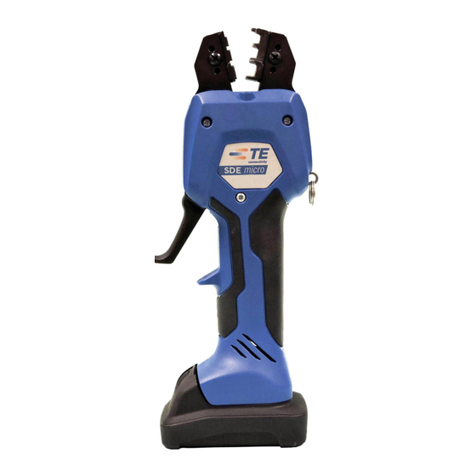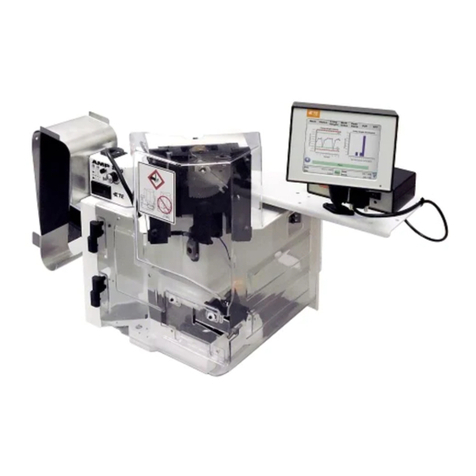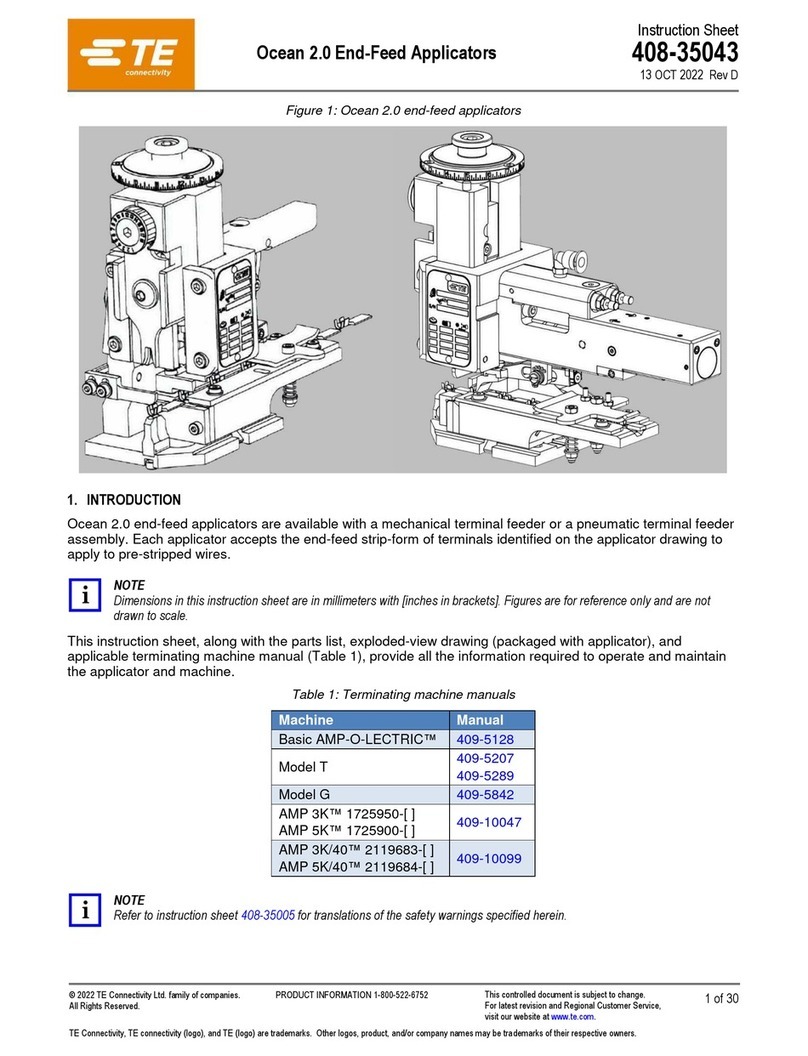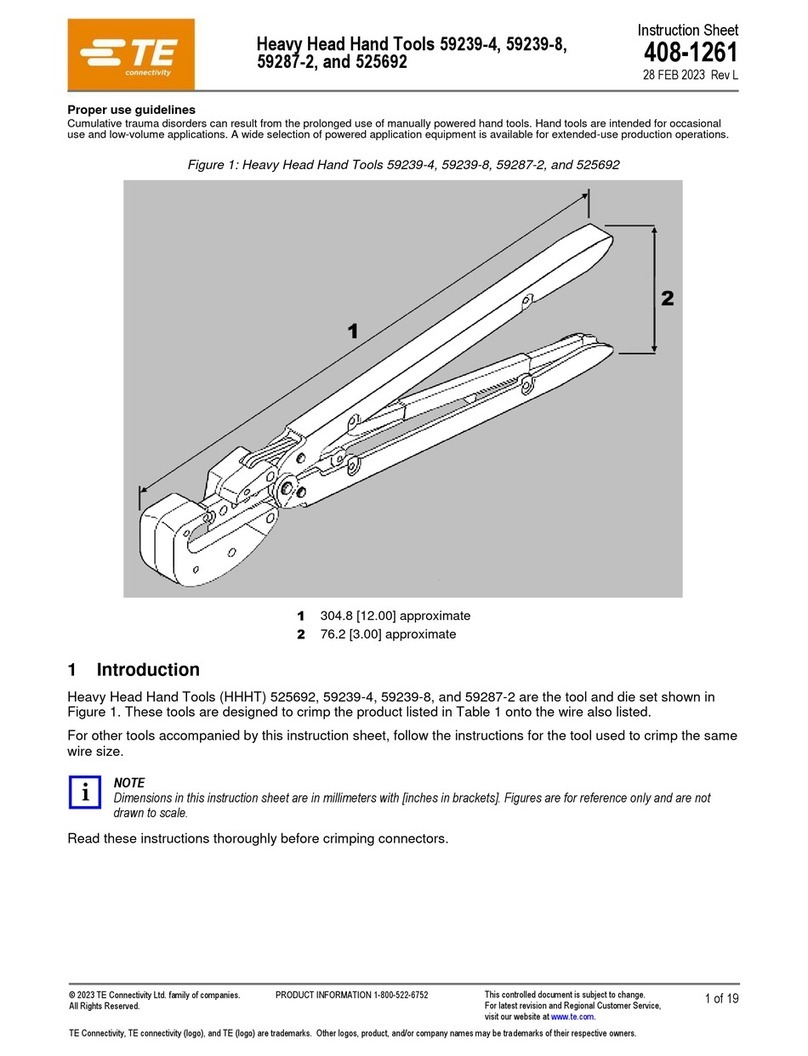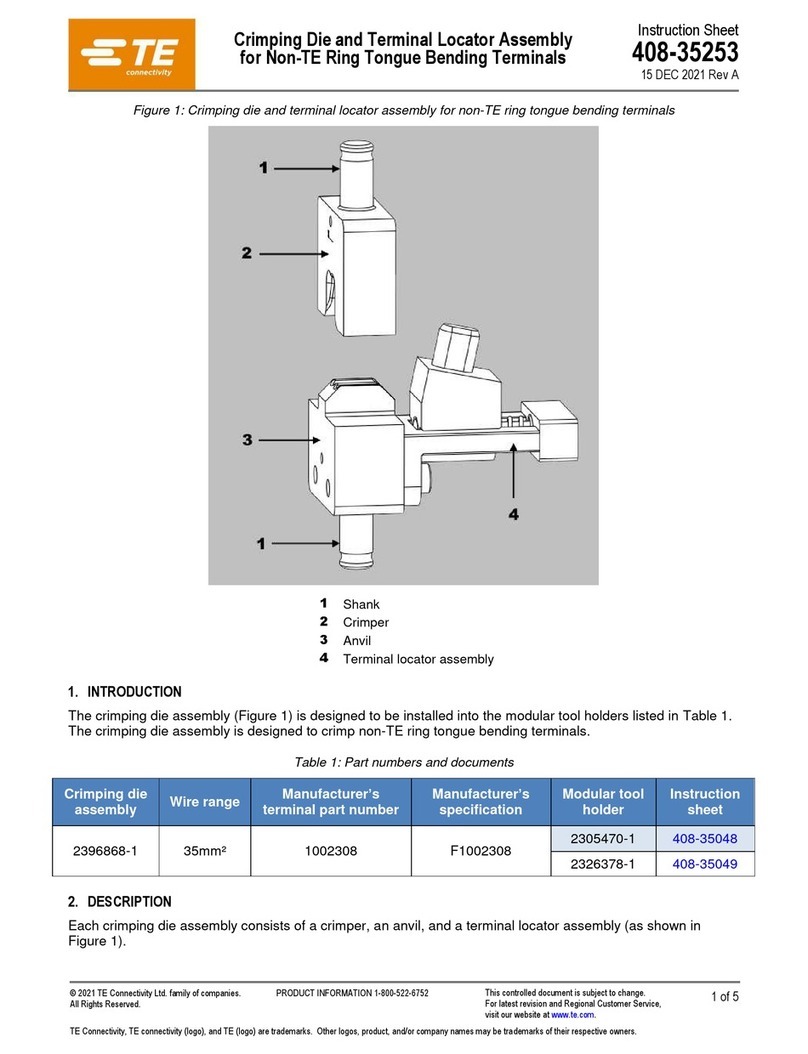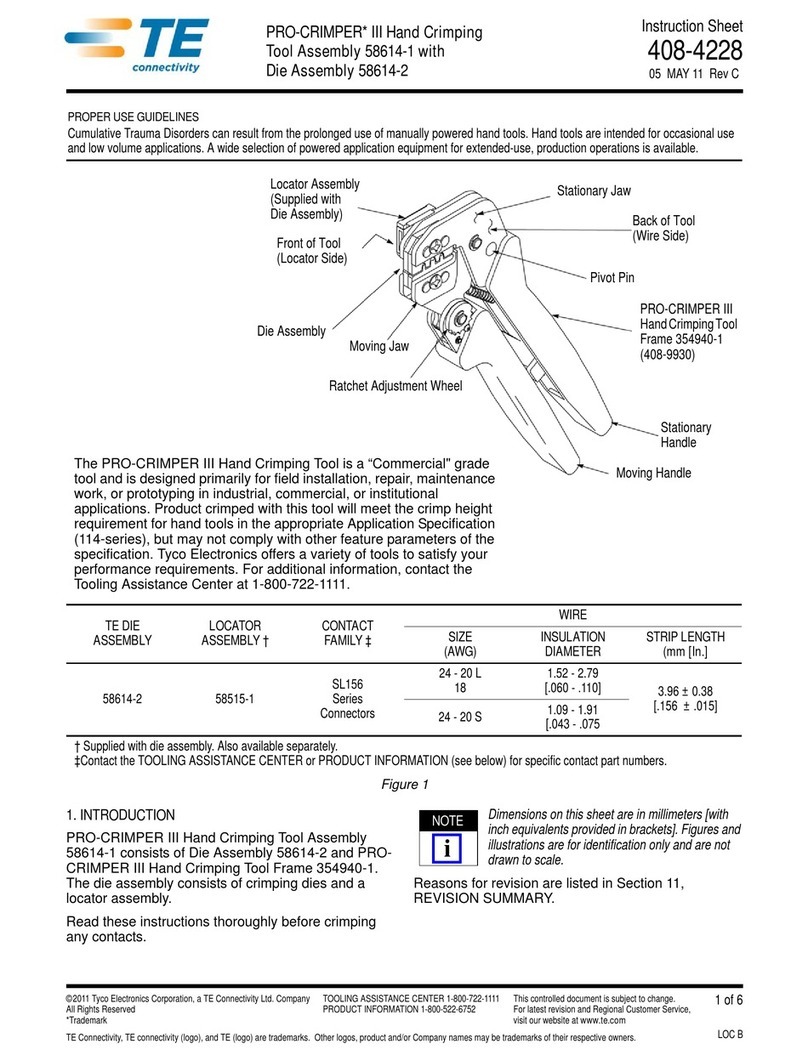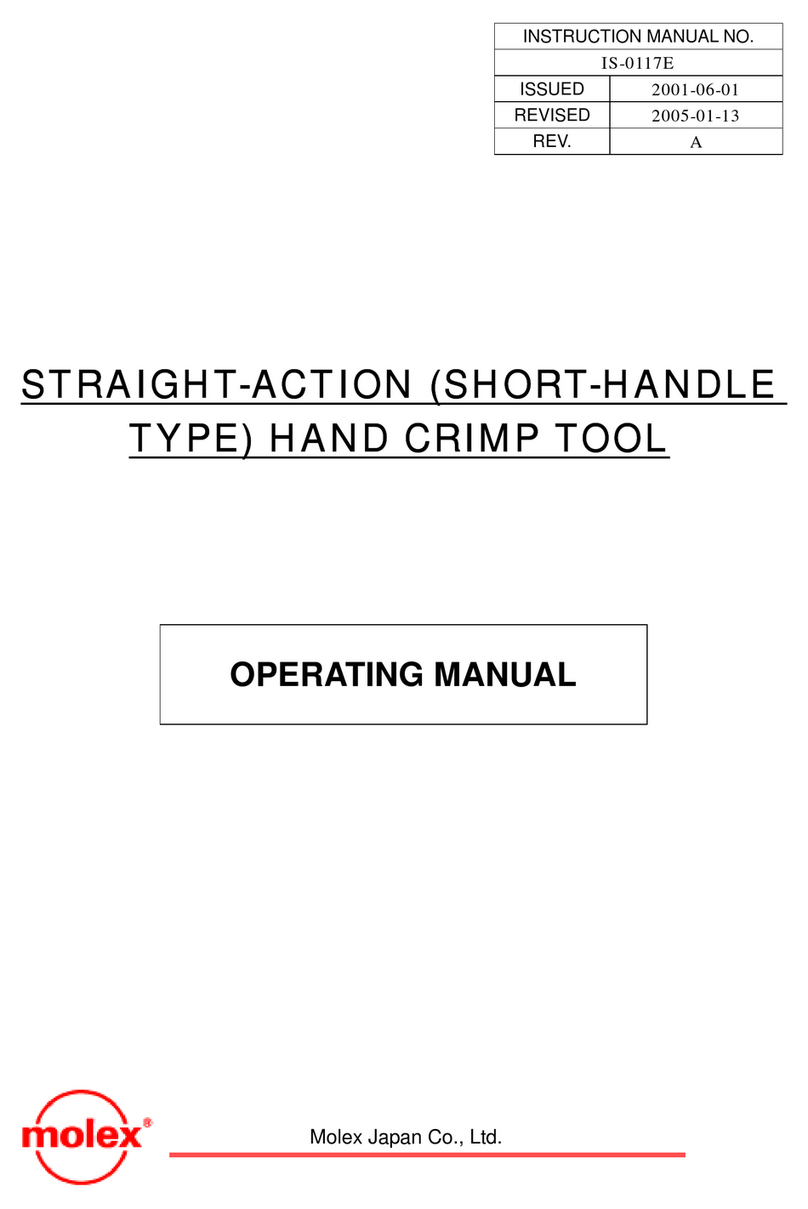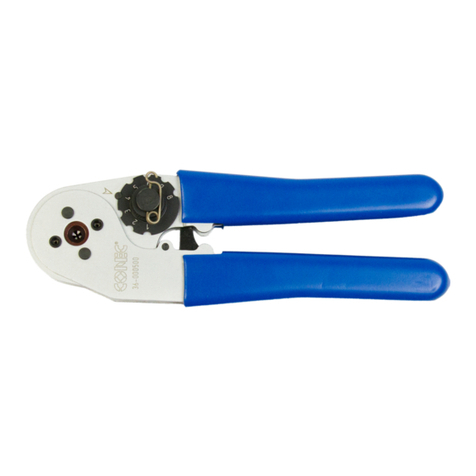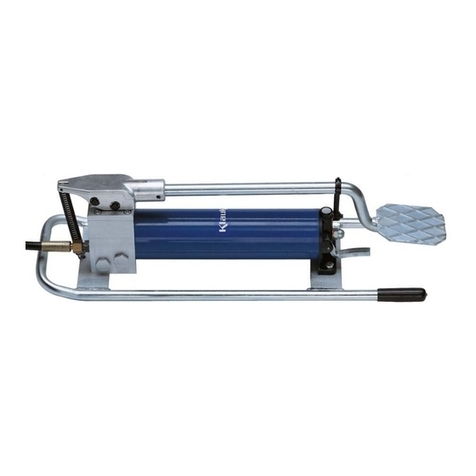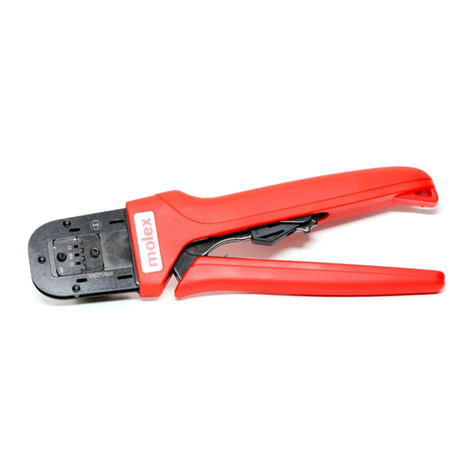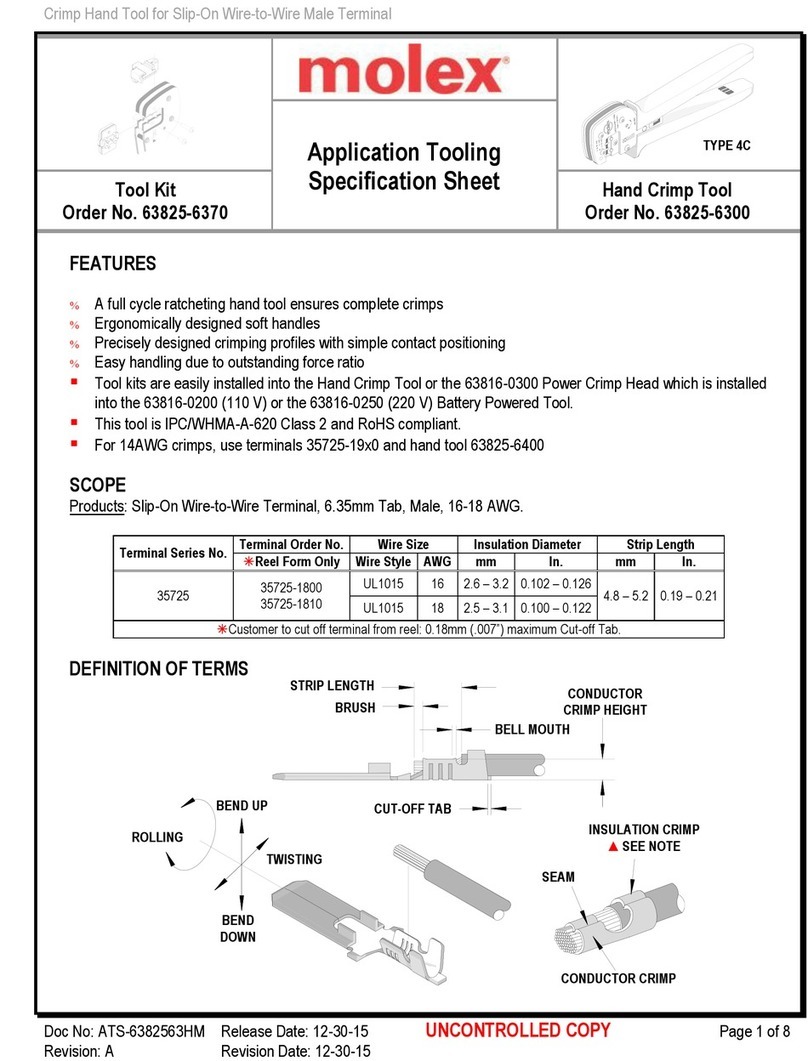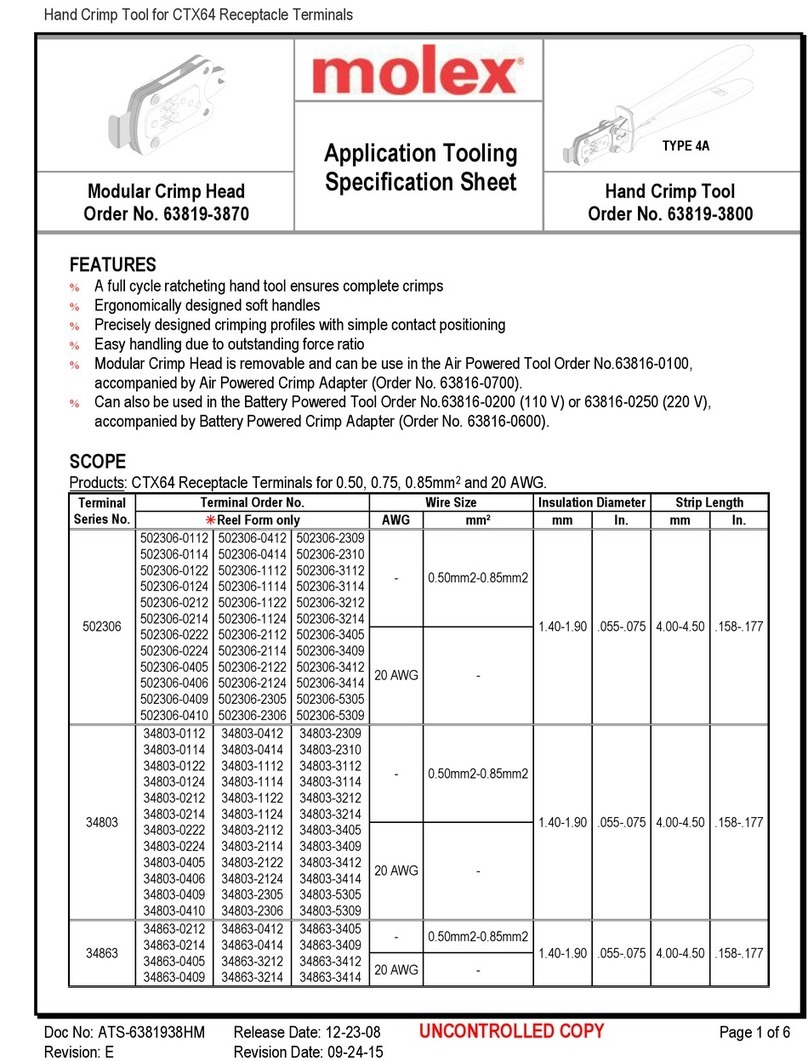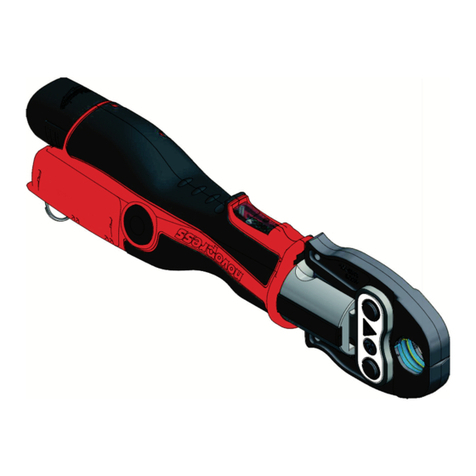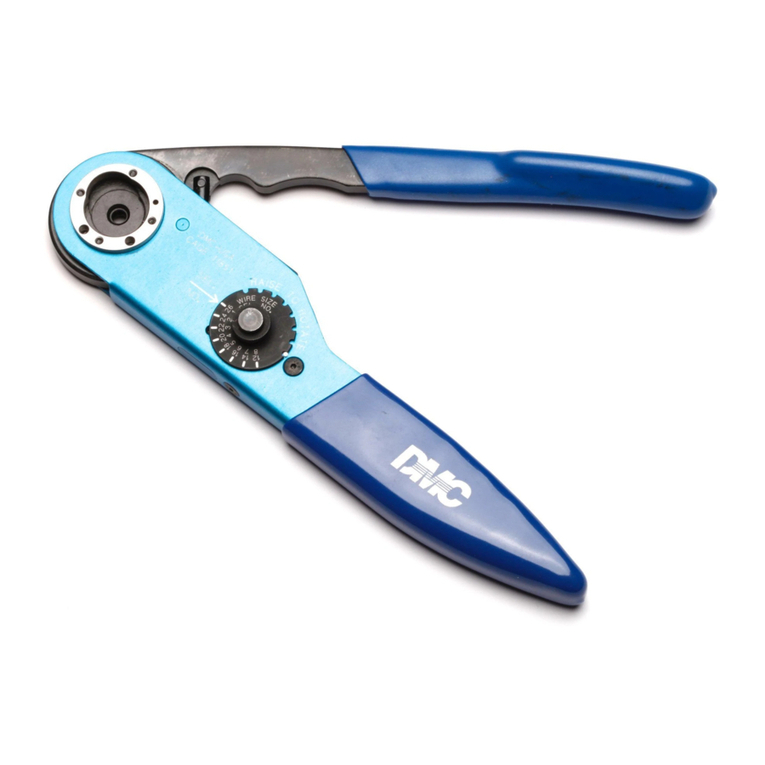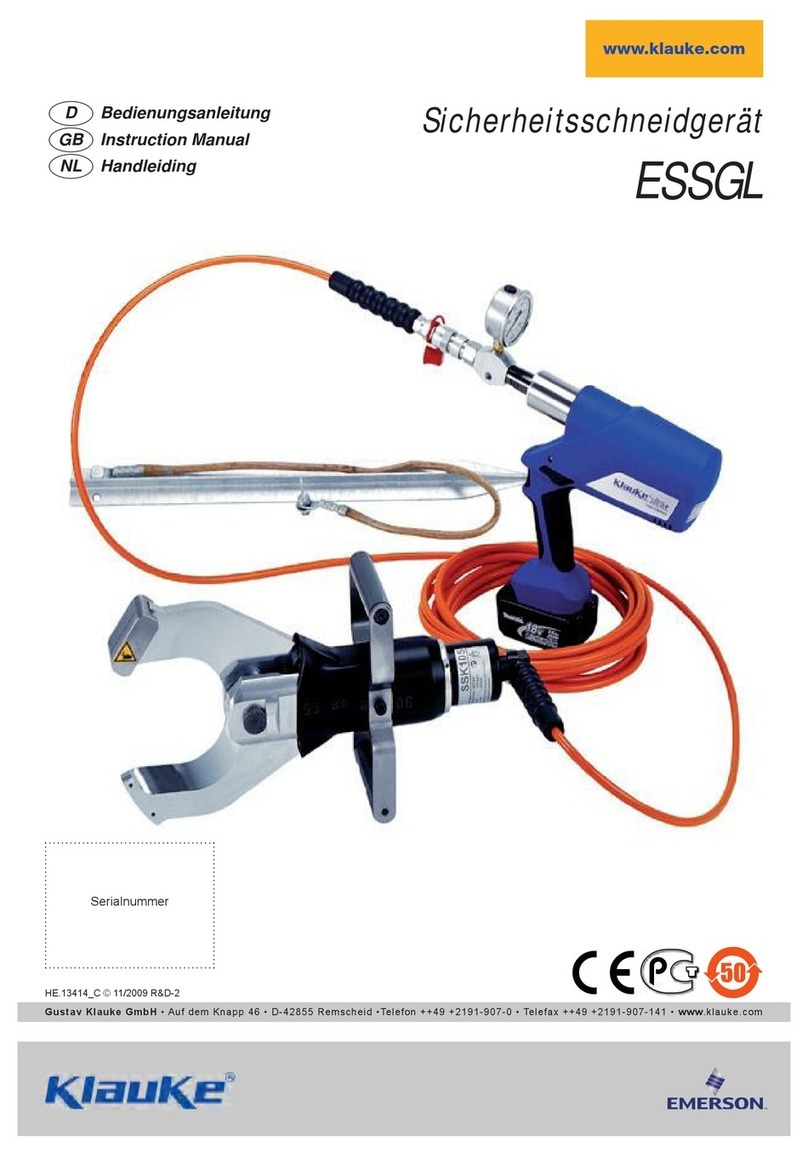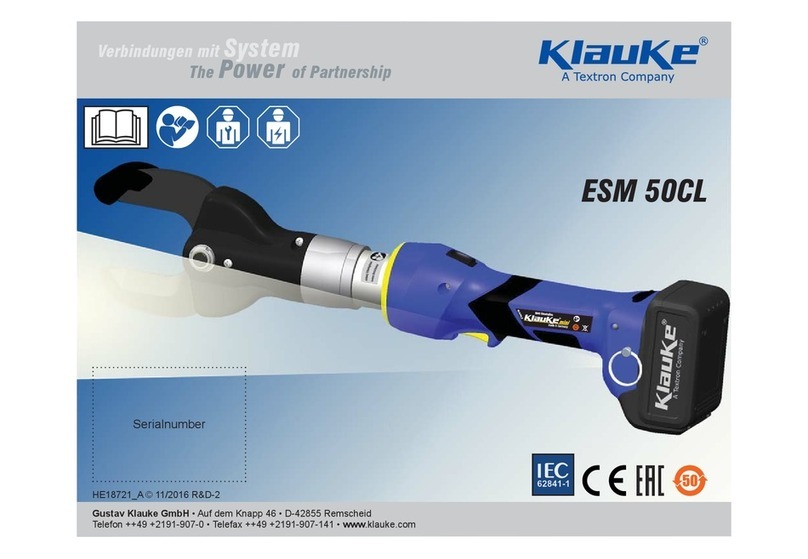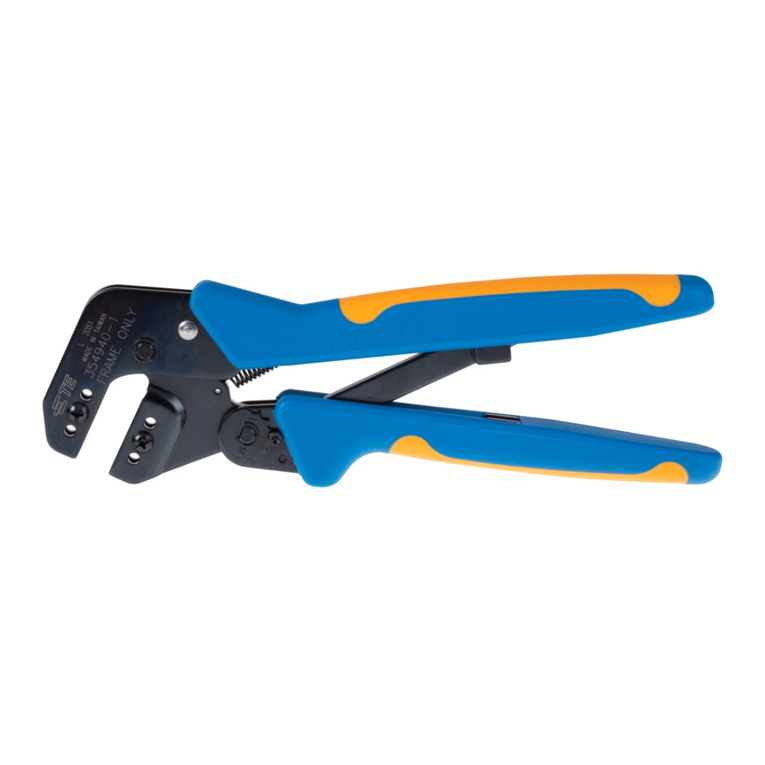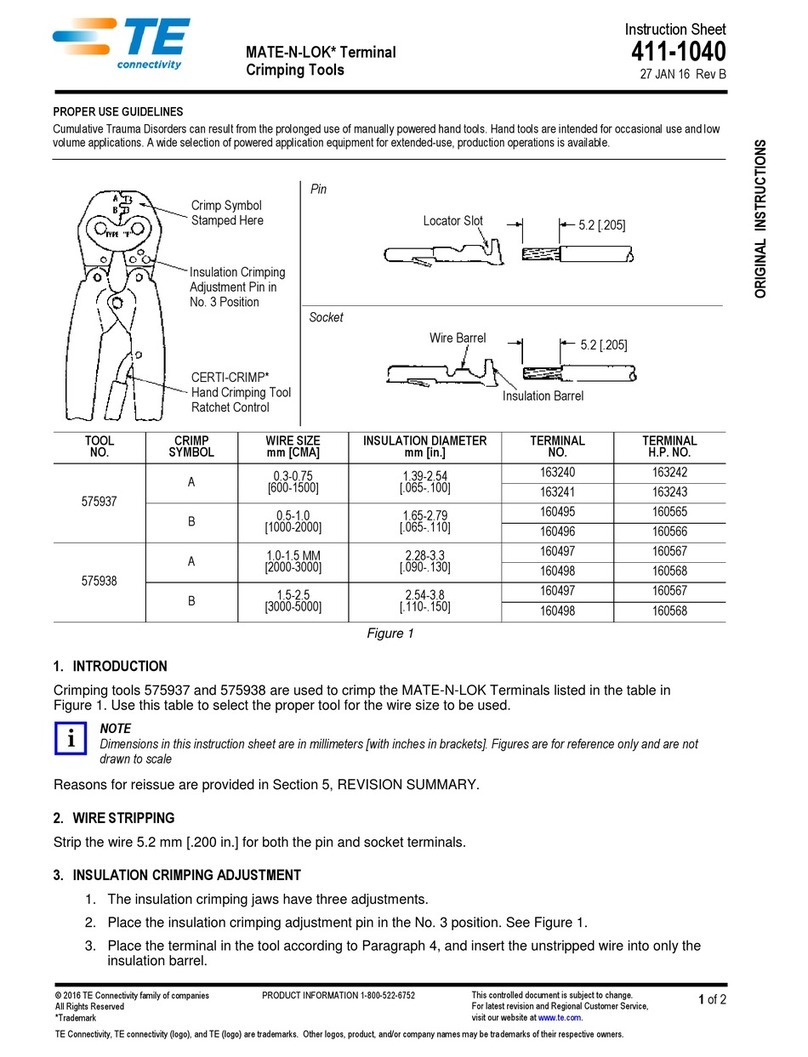TE SDE PEW 12 User manual

Hand Crimping tool Frame Assembly
9-1478240-0 (408-8851)
Stationary Jaw
Indenter (Upper) Die
Die Set 1725724-1
Anvil (Lower) Die
Moving Jaw
Ratchet Adjustment Wheel
Die Retention Screws
Retaining Pins
(4) Required
Emergency Ratchet Release
Handle
DIE ASSEMBLY PART NUMBER CONTACT WIRE
SIZE, mm² STRIP LENGTH
1725724-2 926823-2 0.5
0.75
1.0 8.6 ±0.5 [.339 ±.020]
©2012 Tyco Electronics Corporation, a TE Connectivity Ltd. company
All Rights Reserved
*Trademark
TE Connectivity, TE connectivity (logo), and TE (logo) are trademarks. Other logos, product and/or company names may be trademarks of their respective owners.
1of 3
Instruction Sheet
TOOLING ASSISTANCE CENTER
1-800-722-1111
PRODUCT INFORMATION
1-800-522-6752
This controlled document is subject to change.
For latest revision and Regional Customer Service,
visit our website at www.te.com
408-8881
SDE PEW 12
Hand Tool 1725724-1
with Die Set 1725724-2 19 JUN 12 Rev A
PROPER USE GUIDELINES
Cumulative Trauma Disorders can result from the prolonged use of manually powered hand tools. Hand tools are intended for occasional use
and low volume applications. A wide selection of powered application equipment for extended-use, production operations is available.
Figure 1
1. NTRODUCTION
SDE PEW 12 Hand Tool 1725724-1 consists of SDE
PEW 12 Frame Assembly 9-1478240-0 and die set
1725724-2. See Figure 1. The tool is used to crimp
wire pin 926823-2.
NOTE
i
Dimensions in this instruction sheet are in
millimeters[withinchesin brackets].Figuresarefor
reference only and are not drawn to scale.
Reasons for reissue are provided in Section 9,
REVISION SUMMARY.
2. DESCRIPTION
The tool frame features two jaws, a handle, ratchet
adjustment wheel, and an emergency ratchet release.
The die set consists of an indenter (upper die) and an
anvil (lower die). The tool frame holds a die assembly
with three crimping chambers. See Figure 1. Die
retaining pins and die retaining screws are used to
position and secure the dies in the tool frame.
The tool features a ratchet and an adjustment wheel
with a range of settings. The ratchet ensures that the
tool has completed the cycle and will not release until
the handles have been FULLY closed, unless the
emergency ratchet release is rotated to manually
release the ratchet. The adjustment wheel controls the
amount of handle pressure exerted on the dies during
the crimping procedure.
!
CAUTION
The dies bottom before the ratchet releases. This
feature ensures maximum tensile performance of
the crimp. DO NOT re-adjust the ratchet.
3. DIE INSTALLATION
1. Close tool handles until the ratchet releases, then
allow the handles to open FULLY.

NOTE
i
408-8881
2of 3
Rev A
2. Insert the indenter into the stationary jaw so that
the chamfer faces outward.
3. Place two retaining pins through the tool frame
and indenter.
4. Thread, but do not tighten, a die retention screw
through the center hole in the jaw so that the die is
held in place.
5. Insert the anvil into the movable jaw so that the
chamfer faces outward.
6. Place two retaining pins through the tool frame
and anvil.
7. Thread, but do not tighten, a die retention screw
through the center hole in the jaw so that the die is
held in place.
8. Slowly close the tool handles, allowing the dies to
mate and align. Continue closing the handles until
the ratchet makes the fifth “click”, then tighten both
die retention screws.
The ratchet has detents with audible “clicks” as the
handles are closed. The ratchet releases on the
sixth “click”.
4. CRIMPING PROCEDURE
NOTE
i
This tool is provided with a crimp adjust feature.
Initially, the crimp height should be verified as
specified in Figure 3. Refer to Section 5, CRIMP
HEIGHT INSPECTION, and Section 6, CRIMP
HEIGHT ADJUSTMENT, to verify crimp height
before using the tool to crimp desired contacts and
wire sizes.
Refer to the table in Figure 1 and select wire of the
appropriate size and insulation diameter. Strip the wire
to the length specified in Figure 1, taking care not to
nick or cut wire strands. Select an applicable contact
and identify an appropriate crimp section according to
the wire size markings on the tool.
NOTE
i
1. Squeeze the tool handle together until the ratchet
releases. Allow the tool handles to open FULLY.
Keep wire pins in strip form during
crimping procedure.
!
CAUTION
2. Holding the wire pins by the strip, place the wire
pin on the end of the strip in the appropriate crimp
section.
3. Position the wire pin so that it is centered in the
crimp section and squeeze the tool handles
together until the ratchet engages sufficiently to
hold the wire pin in place without deforming it.
Make sure that both sides of the wire barrel are
started evenly into the crimping section. Do NOT
attempt to crimp an improperly positioned contact.
Wire Pin Shown in Strip Form Wire Inserted in
This Direction
Figure 2
NOTE
i
4. Insert stripped wire into wire pin. See Figure 2.
5. Holding the wire in place, squeeze tool handles
together until ratchet releases. Allow tool handles to
open and remove the crimped contact.
6. Break the crimped contact free from the rest of
the strip by bending the contact back and forth.
7. Check the contacts crimp height as described in
Section 5, CRIMP HEIGHT INSPECTION. If
necessary, adjust the crimp height as described in
Section 6, CRIMP HEIGHT ADJUSTMENT.
Damagedwirepinsshouldnotbeused.Ifdamaged
wire pins are evident, they should be replaced with
new ones.
5. CRIMP HEIGHT INSPECTION
Crimp height inspection is performed using a
micrometer with a modified anvil, commonly referred
to as a crimp height comparator. Refer to instruction
sheet 408-7424 for detailed information on obtaining
and using a crimp height comparator.
Proceed as follows:
1. Refer to Figure 1 and select a wire (maximum
size) for each crimp section listed.
2. Refer to Section 4, CRIMPING PROCEDURE,
and crimp the contact(s) accordingly.
3. Using the crimp height comparator, measure the
wire barrel crimp height listed in Figure 3. If the
crimp height conforms to that shown in the table,
the tool is considered dimensionally correct. If not,
the tool must be adjusted. Refer to Section 6,
CRIMP HEIGHT ADJUSTMENT.

408-8881
3of 3
Rev A
Figure 3
6. CRIMP HEIGHT ADJUSTMENT
Although the ratchet is preset prior to shipment, it is
important to verify the crimp height using a micrometer
or caliper. General use and subsequent wear may
cause the tool to go out of adjustment. It is
recommended that crimp height be inspected, and the
ratchet be adjusted, if necessary, on a regular basis.
Refer to Figure 4, and proceed as follows:
Adjustment Screw
Ratchet Adjustment Wheel
1. If the crimp height is larger than recommended,
remove the ratchet wheel adjustment screw and
rotate the adjustment wheel counterclockwise (+) to
a higher setting. Reinstall the screw. Repeat as
required.
2. If the crimp height is smaller than recommended,
remove the ratchet wheel adjustment screw and
rotate the adjustment wheel clockwise (-) to a lower
setting. Reinstall the screw. Repeat as required.
3. If the crimp cannot be made to conform to the
recommended crimp height, the tool or die set must
be replaced. See Section 8, REPLACEMENT.
Figure 4
7. MAINTENANCE AND INSPECTION
7.1. Daily Maintenance
1. Remove dust, moisture, and other contaminants
with a clean, soft brush, or a clean, soft, lint-free
cloth. DO NOT use any objects that could damage
the dies or tool.
2. Make sure that the proper die retaining screws
are properly secured.
3. When the tool is not in use, keep the handles
closed to prevent objects from becoming lodged in
the dies. Store the tool in a clean, dry area.
4. Remove all lubrication and accumulated film from
the dies by immersing the dies in a suitable
commercial degreaser.
7.2. Inspection
1. Close the tool handles until the ratchet releases,
and then allow them to quickly open freely. If they
do not open quickly and fully, the spring is defective.
See Section 8, REPLACEMENT.
2. Inspect the crimping surfaces of the dies for
flattened, chipped, worn, or cracked areas. If
damage is evident, the dies must be replaced. Refer
to Section 8, REPLACEMENT.
8. REPLACEMENT
Order replacements through your representative, or
call 1-800-526-5142, or send a facsimile of your
purchase order to 717-986-7605, or write to:
CUSTOMER SERVICE (038-035)
TYCO ELECTRONICS CORPORATION
PO BOX 3608
HARRISBURG PA 17105-3608
9. REVISION SUMMARY
Since the previous version of this document, the
following changes were made:
•Updated crimp height comparator information.
•Updated document to corporate requirements.
WIRE SIZE,
mm² (MAX)
CRIMP SECTION
(WIRE SIZE
MARKINGS)
CRIMP HEIGHT
DIMENSION “A” AND
TOLERANCE
0.5 0.5 1.35 ±0.05 [.053 ±.002]
0.75 0.75 1.45 ±0.05 [.057 ±.002]
1.0 1.0 1.55 ±0.05 [.061 ±.002]
Position Point on
Center of Wire
Barrel Opposite
Seam
Modified Anvil “A”
This manual suits for next models
2
Other TE Crimping Tools manuals
Popular Crimping Tools manuals by other brands
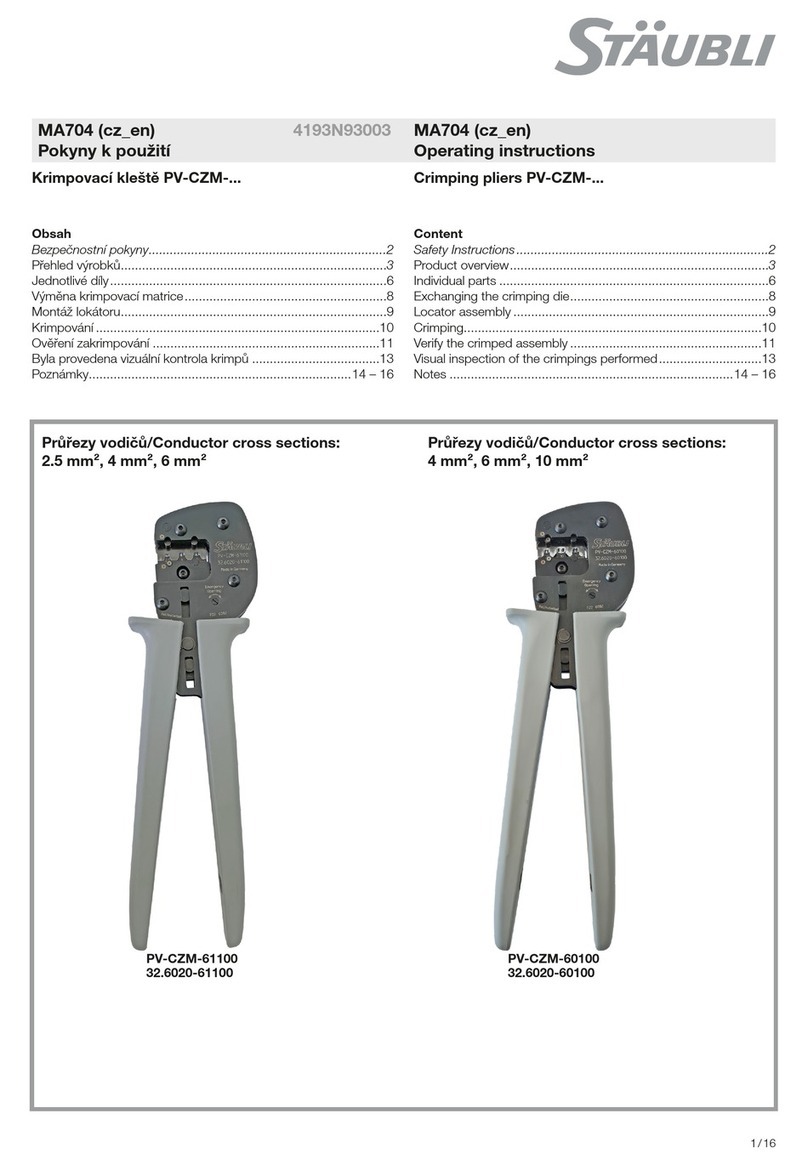
Staubli
Staubli PV-CZM Series operating instructions
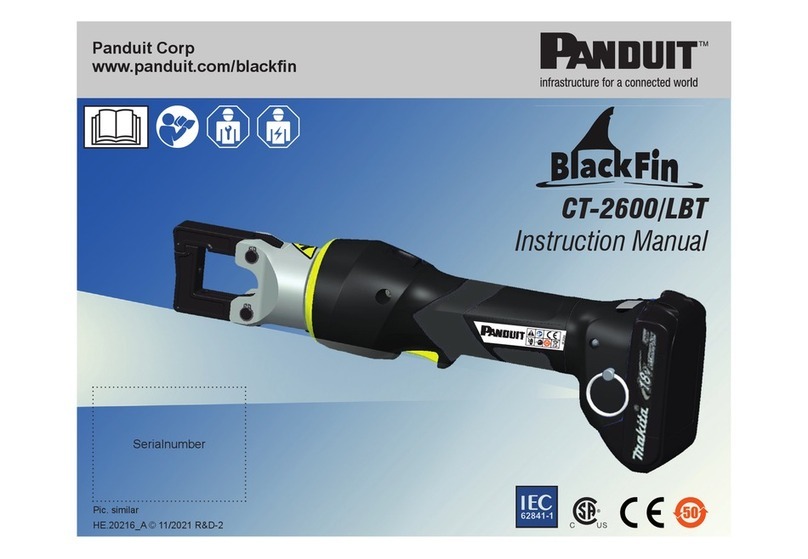
Panduit
Panduit BlackFin CT-2600/LBT instruction manual
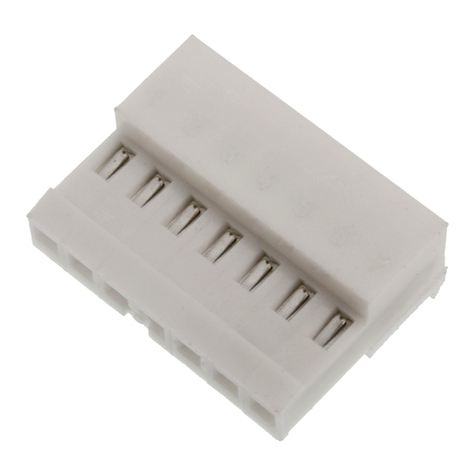
molex
molex MTA-100 Setup instructions
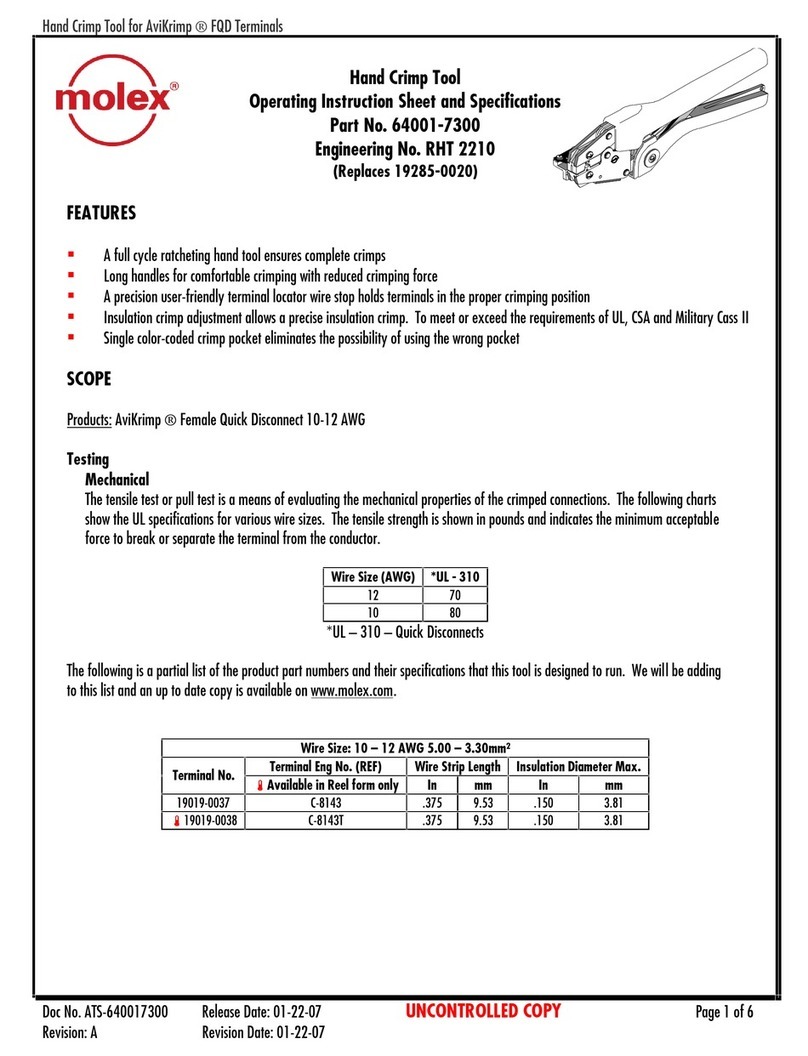
molex
molex 207129 Series Operating Instruction Sheet And Specifications

molex
molex 105300 Series quick start guide
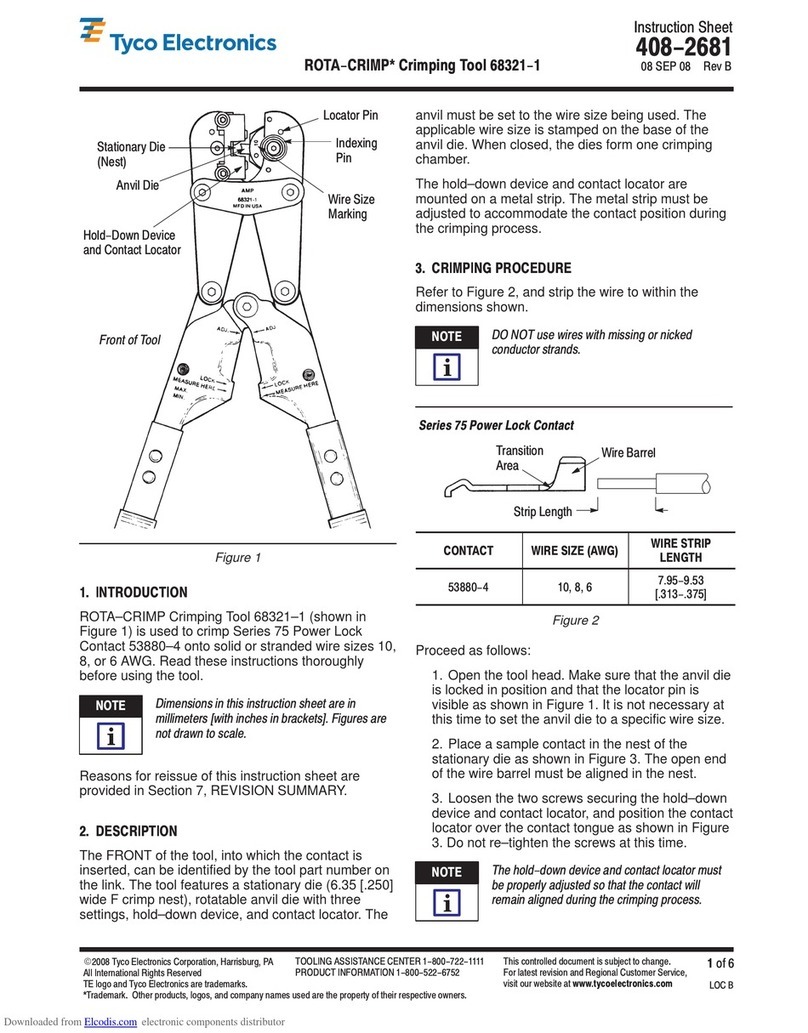
Tyco Electronics
Tyco Electronics ROTA-CRIMP 68321-1 instruction sheet
